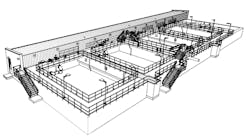Aerobic granular sludge (AGS) consists of microbial granules and biopolymers. These provide density to the AGS that allows it to possess a relatively higher settling velocity than flocs. AGS is used for the removal of toxic pollutants from wastewater.
What is the history of aerobic granular sludge (AGS)?
- In 1980: Granular sludge was described for anaerobic systems by Lettinga et al.
- By the late 1990s: Publications on the formation and application of aerobic granules made available.
- 2003: Patent granted on Method for acquiring grain-shaped growth of a microorganism in a reactor.
The development of AGS was necessary because the anaerobic granulation technology had several drawbacks, namely that it included a long start-up period, a relatively high temperature requirement for operation, unsuitability for application in low strength organic wastewater, and low efficiency in its removal of nitrogen and phosphorus from wastewater.
Several milestones have been achieved since the development of AGS as a technology. These include the development of:
- Compact structured aerobic sludge granules containing diverse microbial species and possessing excellent settling capabilities in sequencing batch reactors
- Densely packed microbial aggregates with densities higher than that of conventional activated sludge
- Using AGS to treat high strength wastewater
What is the aerobic granular sludge (AGS) process?
In the AGS process, influent wastewater enters the tank that has the AGS operating conditions. The AGS process effectively removes pollutants including phenols, nitroaromatics, phthalates, and pharmaceuticals.
The operating conditions, namely anaerobic, aerobic, and short-settling phases in the sequencing batch reactor in a wastewater treatment plant (WWTP) allow for the growth of slow-growing microorganisms such as nitrifying bacteria and polyphosphate-accumulating bacteria. These microorganisms form dense aggregates and thus, their settling velocity is higher than that of flocs and as a result, they are retained in the sequencing batch reactors for wastewater treatment.
Granular formation is crucial for forming a core of bacterial colonization. A research study proposed that the fungal filaments, although AGS is dominated by microorganisms, play a crucial role in the initial stages for the formation of granules in AGS.
Another proposed mechanism for the AGS granulation process involves four stages:
- Stage 1: The microbe-to-microbe contact-forming aggregates are influenced by hydrodynamic and thermodynamic forces among other factors.
- Stage 2: Physical forces such as van der Waal forces, chemical bonding such as ionic binding, and biochemical factors such as membrane fusion lead to the production of aggregates.
- Stage 3: Secretion of EPS as a biological glue for the aggregate.
- Stage 4: Hydrodynamic shear forces sustain the 3-D structure of the granule.
The extracellular polymeric substances (EPS) matrix is the key component for promoting microbial colonization in the formation of AGS. The EPS matrix is composed of proteins and polysaccharides along with nucleic acids and humic acids. Granulan and alginate-like exopolymers are two kinds of structural EPS recovered from AGS from municipal wastewater. These EPS structures were recovered using sodium hydroxide and sodium carbonate.
The sequencing batch operating conditions include fill-and-draw operation, anaerobic feeding phase, bubble aeration, and short settling time. The anaerobic phase assists in the hydrolysis of biodegradable organic matter and in the fermentation of organic matter.
What are the advantages and disadvantages of aerobic granular sludge (AGS)?
The advantages of AGS
AGS has excellent settling ability along with the ability to treat high-strength, toxic wastewater.
AGS allows effective biomass and water separation. It also allows simultaneous nitrification, denitrification, and phosphate removal from wastewater in a single reactor tank.
AGS minimizes the energy consumption by 30-48% compared to conventional activated sludge process in a WWTP.
The disadvantages of AGS
It takes time for the components in the AGS to form. Because AGS is composed of microorganisms, it also takes time for the microbial cells to aggregate to form the AGS structure.
AGS disintegrates under high rates of organic loading. A reported study showed that in a sequencing batch reactor operated under an organic loading rate of 9 to 21.3 kg chemical oxygen demand (COD) m-3/day-1 with acetate as the sole carbon and energy source for the AGS.
The granules in the AGS removed 94% to 96% of the fed COD at an organic loading rating of up to 9 to 19.5 kg COD m-3/day -1 and disintegrated at an organic loading rating of 21.3 COD m-3/day -1.
Under the organic loading of organic loading rating of 21.3 COD m-3/day -1, the study showed reduced amounts of proteins secreted by the microbial isolated from the AGS associated with poor integration of the granule.
How does aerobic granular sludge (AGS) compare to activated sludge?
Because the conventional activated sludge generates sludge in a WWTP, AGS is an alternative that produces relatively low amount of sludge. However, post treatment might be necessary depending on the composition of the incoming wastewater in the WWTP.
Recommended readings
About the Author
Saleha Kuzniewski
Saleha Kuzniewski, Ph.D. has authored several publications in the fields of scientific research, biotechnology, and environmental regulations. She is the winner of the 2023 Apex award for publication excellence. She is also the founder of Environmental Remediation & Innovations, LLC. Kuzniewski can be reached at [email protected].


